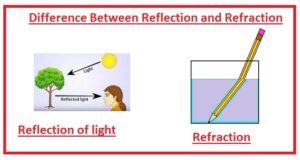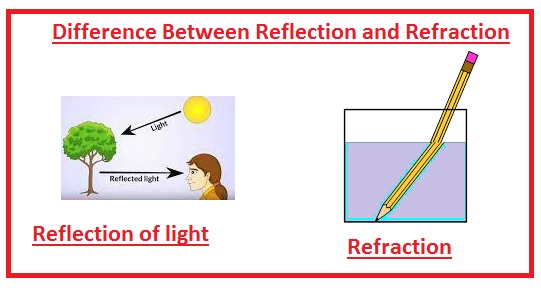 Hello guys, I hope you all are doing great. In today’s tutorial, we will have a look at Difference Between Reflection and Refraction. There are 2 main properties related to the propagation of light that reflection and refraction. after colliding the light with different mediums comes back to the first medium is called reflection that is not happening in refraction. While in refraction light moving from one medium to another it bends or changes direction.The straight path over which light moves is known as a ray of light and large numbers of rays in group form is called beam of light
Hello guys, I hope you all are doing great. In today’s tutorial, we will have a look at Difference Between Reflection and Refraction. There are 2 main properties related to the propagation of light that reflection and refraction. after colliding the light with different mediums comes back to the first medium is called reflection that is not happening in refraction. While in refraction light moving from one medium to another it bends or changes direction.The straight path over which light moves is known as a ray of light and large numbers of rays in group form is called beam of light
As we know that electromagnetic radiation has a wavelength of four hundred to seven-fifty nanometer is known as light. Our eye can easily detect this range of wavelengths. . In today’s post, we will have a detailed look at reflection and refraction and compare them. So let’s get started with a Difference Between Reflection and Refraction.
Difference Between Reflection and Refraction
Reflection
- The variation in the wavefronts when meets between two different medium and waves come back to the previous medium
- the basic example of reflection is light, water waves reflection.
- Law of reflection says the angle with which the wave collides to the material is the same to the reflected angle.
- This phenomenon called specular reflection and shown by mirror
- in the sound example of reflection is echoes and applied in sonar
- radar operation based in reflection.
- A seismic wave is an example of reflection.
- A mirror provides the most common
- It has two natures specular and diffuse.
- It occurs in electromagnetic waves.
- X rays also show reflection nature
- The speed of the reflection ray remains the same to after reflection.
- This phenomenon occurs on the shiny surface.
- Reflection has 2 types of regular and diffused reflection.
- Its propagating medium remains the same
- In the reflection angle of incidence and angle of reflection, both are similar.
- These phenomena occur usually in the mirrors.
Refraction
- Refraction is the bending of light when it moves from one medium to another.
- The variation in the direction of waves moving from the first medium to another called refraction.
- Light as well water waves also show this process.
- The change in speed and direction of a wave tells the refraction of the wave
- The refraction based on snell law in the case of light.
- That says that the angle of incidence and angle refraction ratio is equal to the speed ratio.
- sinθ1/sinθ2=n2/n1
- n2 and n1 is refractive indexes
- lens uses this process to refract light
- the change in the refractive index according to wavelength is called dispersion
- For this process path of light changes when it moves from one medium to another.
- The speed of light changes according to the medium in which light is going to be refracted.
- This phenomenon occurs on a transparent surface.
- There is one type of refraction.
- This phenomenon occurs in lenses.
- For reflection angle of incidence and angle of reflection are not similar.
Laws of Reflection
- There are 2 main laws that explain the reflection.
- First is the angle of incidence is the same to the angle of reflection.
- Second is reflected ray, incident ray and normal all exist in same plane.
Types of Reflection
- There are 2 main types of reflection. The first is a specular reflection and the second one is diffuse reflection.
Specular Reflection:
- If the reflection is occurring in such a medium that has plan surface such as a mirror is called specular reflection.
Diffuse Reflection:
- If the medium from which light is reflecting is not smooth such as paper or cloth is called diffuse reflection.
That all about Difference Between Reflection and Refraction if you have any query ask in comments. Thanks for reading. have a good day.







